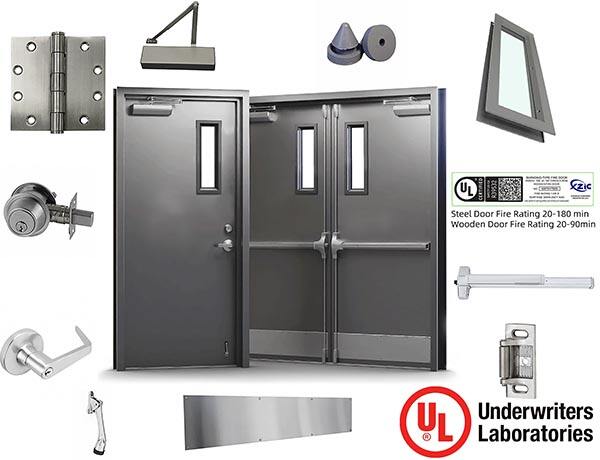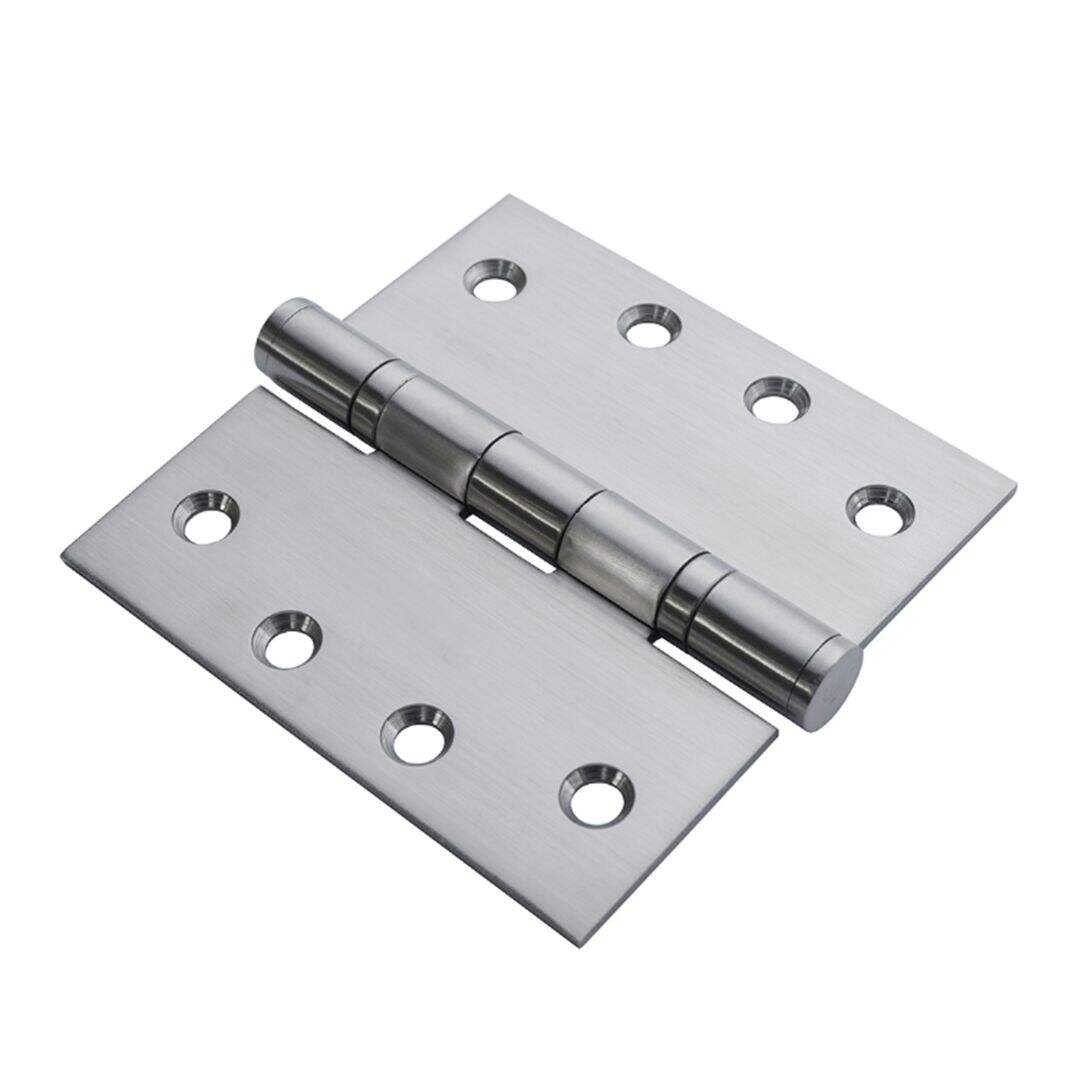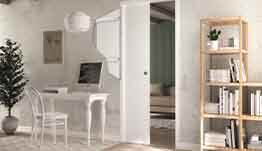Auswahl von Feuerschutztür-Hardware - Scharnier
Für Brandschutztüren sind zweifellos unter den benötigten Hardware-Zubehörteilen eine Hauptfunktion enthalten, nämlich feuerfest zu sein. Im vorherigen Artikel haben wir besprochen, wie man den richtigen Türaufsteller für Brandschutztüren auswählt. In diesem Artikel werden wir weiterhin Methoden und Erkenntnisse bereitstellen, um Ihnen bei der Auswahl der richtigen Scharniere zu helfen.
Funktionen von Scharnier
Die Hauptfunktionen von Scharnieren lassen sich in zwei miteinander verbundene Teile unterteilen. Der erste ist die Verbindung zwischen Türblatt und Türstock, wobei das Gewicht des Türblatts getragen wird und auf den Türstock übertragen wird, so dass das Türblatt in einer geeigneten Höhe (auf einer bestimmten Entfernung vom Boden) gehalten wird. Der zweite ist die Sicherstellung, dass das Türblatt rotieren kann, um normale Öffnung und Schließung der Tür zu ermöglichen und die Ausrichtung und den Spalt zwischen Türblatt und Türstock zu kontrollieren.
Zwecke von Scharnier
Scharniere sind in verschiedenen Anwendungen unerlässlich, insbesondere bei Feuerschutztüren mit folgenden Zwecken:
Sicherheit und Brandschutz : In Feuerschutztüren stellen Scharniere sicher, dass die Tür sicher befestigt und richtig ausgerichtet bleibt, um eine Feuer- und Rauchbarriere aufrechtzuerhalten.
Langlebigkeit : Hochwertige Scharniere gewährleisten eine langfristige Funktionsfähigkeit in Bereichen mit hohem Durchgangsverkehr wie Bürogebäuden, Schulen oder Krankenhäusern.
Sicherheit : Scharniere, insbesondere solche mit nicht entfernbaren Stiften, erhöhen die Türsicherheit, indem sie eine unbefugte Entfernung verhindern.
Ästhetische Anziehungskraft : Bestimmte Scharnierarten, wie verborgene Scharniere, bieten ein schlichtes, modernes Aussehen für architektonische Designs.
Spezialisierte Funktionalität : Spezifische Scharnierarten (z. B. Federscharniere) bieten zusätzliche Funktionen wie Selbstschließfunktion, was die Abhängigkeit von separaten Schließern reduziert.
Feuerschutzstandards für Scharnier
Scharniere für Feuerschutztüren müssen strenge Brandschutzvorschriften erfüllen, um während eines Brandes eine sichere Leistung zu gewährleisten. Wichtige Anforderungen umfassen:
1.Feuerzertifizierungen :
Internationale Standards : Wie UL (USA), EN (Europa) und BS (Vereinigtes Königreich). UL 10C und EN 1935 sind gängige Standards für feuerfeste Scharniere. Diese Standards haben nicht nur anforderungen an Türen, sondern auch spezifische Vorgaben für Hardware.
Chinesische Standards : Übereinstimmung mit Feuerschutztüren für Gebäude (GB 12955-2008), wobei Scharniere eine nationale Feuerproduktzertifizierung (z. B. 3C-Zertifizierung) bestehen müssen.
2.Feuerbeständigkeit :
Feuerfeste Scharniere müssen in Hochtemperaturumgebungen funktionieren (z. B. 30, 60 oder 120 Minuten), ohne ihre Strukturintegrität zu verlieren oder zu versagen.
Materialien wie Stahl oder Edelstahl werden typischerweise verwendet, um Wärmebeständigkeit sicherzustellen und Schmelzen oder Schwächen bei einem Brand zu verhindern.
3.Belastungs- und Zyklustests :
Scharniere müssen Dauerhaftigkeitstests bestehen (z. B. erfordert EN 1935 bis zu 200.000 Zyklen), um eine zuverlässige Funktion bei wiederholtem Gebrauch zu gewährleisten.
Brandtests überprüfen, ob Scharniere die Türausrichtung und -schließung unter simulierten Brandsituationen aufrechterhalten.
4.Sichere Befestigung :
Scharniere müssen während eines Brands sicher an Tür und Rahmen befestigt bleiben und Lücken verhindern, durch die Rauch oder Flammen passieren könnten.
Befestigungselemente (z. B. Schrauben) müssen ebenfalls feuerbeständig sein und mit dem Scharniermaterial kompatibel sein.
Arten und Montagemethoden
·Oberflächenmontage closer : Der gebräuchlichste Typ, mit einem Hebelarm und hydraulischer Dämpfung, auf der Tür oder dem Rahmen montiert, geeignet für die meisten Türtypen.
·Versteckt closer : Innerhalb des Türrahmens oder des Türblatts installiert, ästhetisch ansprechend, aber kompliziert zu montieren, normalerweise ungeeignet für schwere Türen. Häufig in Hotels zu finden.
·Fußfedern : Ideal für Glas- oder schwere Türen, in den Boden eingebaut, kombiniert Schließ- und Positionierungsfunktionen.
·Elektrisch closer : Entworfen für Türen mit automatischem Öffnungsbedarf, bietet Ästhetik, Effizienz und Funktionalität. In Krankenhäusern reduzieren sie auch kontaktbasierte Übertragungen.
Wichtig Die Kommission
1.Kriterien für die Auswahl von Scharnieren :
Türgewicht und -größe : Scharniere müssen dem Gewicht und den Abmessungen der Tür entsprechen. EN 1935 klassifiziert Scharniere nach Tragfähigkeit (Stufen 1–14).
Material : Edelstahl oder Messing wird für Feuerschutztüren bevorzugt, da sie aufgrund ihrer Beständigkeit und Feuerwiderstandseigenschaften geeignet sind. Nichtrostende Metalle verringern Korrosion in äußeren oder feuchten Umgebungen.
Anzahl der Scharniere : Brandschutztüren benötigen normalerweise mindestens drei Scharniere, um Stabilität und Lastverteilung sicherzustellen, wobei schwerere Türen mehr benötigen.
2.Installation und Wartung :
Eine präzise Ausrichtung ist entscheidend, um Verbindungen, ungleichmäßigen Verschleiß oder Lücken zu verhindern, die die Brandschutzleistung beeinträchtigen könnten.
Regelmäßige Inspektionen auf lockere Schrauben, Verschleiß oder Korrosion gewährleisten eine langfristige Zuverlässigkeit.
Schmierung der beweglichen Teile (außer bei selbstschmierenden Scharnieren) sorgt für einen reibungslosen Betrieb.
3.Anpassungsfähigkeit an die Umwelt :
Außenscharniere erfordern korrosionsbeständige Beschichtungen (z. B. pulverbeschichtet oder Edelstahl) zur Widerstandsfähigkeit gegen Feuchtigkeit und Temperaturschwankungen.
In Niedertemperaturen müssen Scharniere funktionsfähig bleiben, ohne spröde zu werden.
4.Sicherheitsmerkmale :
Nicht entfernbare Pins (NRP) oder Sicherheitsbolzen verhindern das Manipulieren von Scharnieren, was wichtig für Außentüren oder hochsichere Brandschutztüren ist.
5.Kompatibilität mit anderer Hardware :
Scharniere müssen sich nahtlos mit Türschließen, Schlössern und anderer Hardware verbinden, um eine ordnungsgemäße Türfunktion und Brandschutzleistung zu gewährleisten.
Wir sind XZIC (Shanghai Xunzhong Industry Co., Ltd.) Wir sind Spezialist für feuerfeste Türen. Unser Unternehmen produziert jährlich 50.000 Satz Stahltüren und 20.000 Satz Holztüren mit Feuerschutz. Wir verfügen über die umfassendste UL-Zertifizierung in China. Unsere hochwertigen feuerfesten Türen sind speziell auf US-amerikanische und kanadische Standards zugeschnitten. Außerdem verwenden wir hochwertige, UL-zertifizierte Hardware. Stahltür bis zu 3-Stunden-Feuerschutz, Holzfeuertür bis zu 90 Minuten. Außerdem fertigen wir auch andere Türarten für den Wohnbereich. Alle Türen können nach Maß angefertigt werden.
Weitere Informationen finden Sie auf unserer Website: www.ulfiredoormfg.com
Kontaktieren Sie unseren Verkaufscontact per E-Mail: [email protected]
Empfohlene Produkte
Top-Nachrichten
-
UL-Brandschutztür: Rechtsvorschriften und Zertifizierungsanforderungen
2025-08-08
-
Welche Arten von Feuerschutztüren gibt es?
2025-07-12
-
Warum sind Hohlmetalltüren eine kosteneffektive Langzeitlösung für Unternehmen?
2025-07-23
-
Wie hoch ist der Preisanstieg für UL-ZERTIFIZIERTE FEUERSCHUTZTÜREN mit Mahagoni/Eiche/Buche/Walnuss-Vollholzdekor im Vergleich zu Formica/TAK/Wilsonart-Laminate-Oberflächen?
2025-07-31
-
Was ist eine MDF-Tür (mitteldichte Faserplatte)?
2025-06-15
-
Wichtige Aspekte der UL-Metall-Feuertür-Inspektion
2024-01-02
-
XZIC liefert hochwertige UL-Feuertüren unserem wertvollen Kunden in Katar
2024-01-02
-
Können leichte Metalltüren isoliert werden?
2024-01-02
 EN
EN
 AR
AR
 BG
BG
 NL
NL
 FR
FR
 DE
DE
 EL
EL
 IT
IT
 KO
KO
 PL
PL
 PT
PT
 RO
RO
 RU
RU
 ES
ES
 TL
TL
 IW
IW
 ID
ID
 UK
UK
 VI
VI
 TH
TH
 FA
FA
 AF
AF
 MS
MS
 SW
SW
 BE
BE
 UR
UR
 BN
BN
 KM
KM
 LO
LO
 LA
LA
 MI
MI
 MN
MN
 MY
MY
 KK
KK
 MG
MG
 SU
SU
 TG
TG
 UZ
UZ
 KY
KY
 XH
XH





